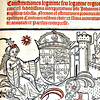
|

|

|
Constitutiones Angliae
Paris: Hopyl, 1504
Ayton's work was a major treatise on English canon law—law of the Roman Catholic church peculiar to the church in England. The work includes a compilation of legislation passed at the councils in London by the papal legates Otto (1237) and Ottobuono (1268), supplemented by Ayton's gloss.
Legal historian Sir John Baker writes that Ayton was primarily a teacher: his gloss is filled with humor and lively examples crafted to keep a student's attention. On one law ordering that clergy should not keep concubines publicly in their houses, but should discard them within a month, Ayton points out that the law does not concern clergy that keep concubines secretly, and that penalty is avoided if a clergy keeps a concubine on and off, as long as he never keeps her for a month at a time. Ayton uses the law as an opportunity to point out in an amusing way the importance of precise draftsmanship. (Baker, Monuments of Endlesse Labours, 1998 at 39)
Printed in red and black with a woodcut of St. George and the Dragon on the title page, this is one of the most beautiful law books ever printed.



![Abridgement of cases to the end of Henry VI [1460]](/_ui/img/treasures/img/thumbs/Picture2.png)





















